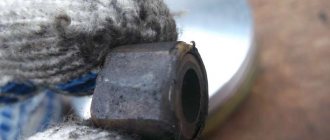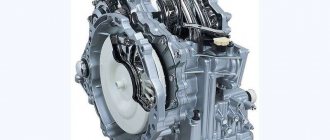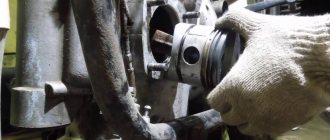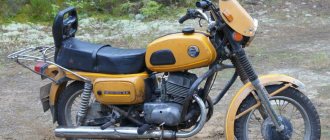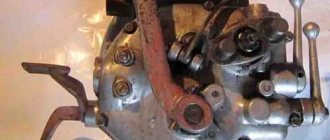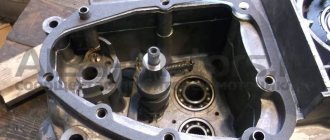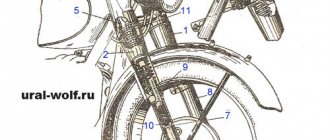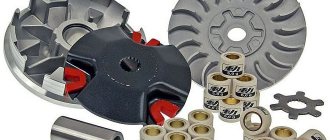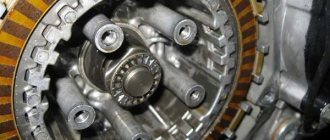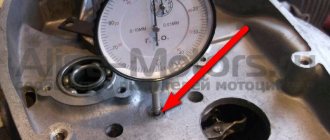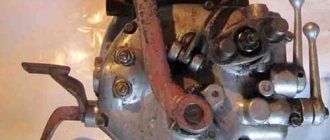Scooter variator device
A variator is a part responsible for a smooth change in speed. It is a unit of two pulleys (driver and driven) connected to a belt. The degree of load on the main variator depends on the intensity of engine rotation. When driving at high speed, the number of rotations is maximum, which is why the variator parts wear out faster.
The belt is attached to the pulley at the sides. If the CVT bushing wears, the belt cuts deeper into the pulley. When the drive pulley operates, the belt smoothly compresses and unclenches. A sports CVT on a scooter makes more revolutions. The belt may need to be replaced sooner.
Even a new scooter can fail over time due to improper use.
To change or not to change?
Suppose you “overhaul” your engine: you change the seals, crankshaft, gaskets and other devices, but you doubt whether to replace the timing chain with a new one or not. If you doubt it in vain, change it for a new one at the first opportunity. And now I will explain why.
See for yourself: a chain has an average service life of approximately 18,000-20,000 km of a scooter (personal experience), approximately the same as the average service life of the engine itself. And for example, after driving 6,000 km, the crankshaft jammed or the engine leaked, or something else happened that requires complete disassembly of the engine. Naturally, you disassemble the engine, replace the crankshaft with a new one, and leave the chain, which by that time has exhausted a third of its service life.
And what happens? The chain, after 12,000 km, will exhaust its service life and become unusable, but the crankshaft and other parts will be in good order and you, like it or not, will have to again, because of the chain alone, half the engine. Is it necessary? The chain is a consumable item. Never skimp on it!
How to replace a belt
The scooter's variator can withstand a mileage of up to 6 thousand km. The belt lasts the same amount of time. The part may last longer, but you still need to regularly diagnose it. You can do it yourself if you have special knowledge in this area.
Symptoms of a problem
- When the speed increases, the engine rotates quickly, but the clutch does not work. In this case, the transport does not budge. This means the belt has broken.
- The carburetor is normal, but it is still impossible to reach the maximum speed. The reason is that the variator does not reach its maximum radius due to damage.
- The belt lasts very little if it is a cheap fake. You need to disassemble the device and evaluate the appearance of the belt. If it is stretched, then it's time to change it. Due to deviation from the desired value, the transmission stops working as it should.
Main causes of failure
The main causes of CVT malfunctions are violation of operating rules:
- rare oil changes;
- use of low-quality oils;
- aggressive driving;
- sudden braking;
- long trips at top speed.
Mileage up to 6 thousand km.
withstands the scooter's variator. The reasons for the breakdown may be other. One of them is a faulty bearing in the variator, which manifests itself in the appearance of a hum. Noise is often attributed to worn wheel bearings, making it difficult for a beginner to identify the real cause of the problem. The difficulty is that the bearings can be damaged even with low mileage due to aggressive driving.
Another cause of damage is metal dust. The chain and variator pulleys rub against each other, so they gradually wear down.
Dust gets into the oil and then to the bearings. To find this dust, oil filters are present in the design. But neither they nor regular oil changes prevent the appearance of dust.
Another reason for variator failure is the accumulation of metal dust in the oil pump. It penetrates the valves and disrupts their operation, and also leads to pressure surges in the pump. The pulleys move chaotically, causing the belt to wear off. As a result, the vehicle jerks while driving. If you don't fix the variator, you'll have to replace the gearbox.
The variator may fail due to belt damage. This part is a device consisting of many plates located on a bundle of metal strips. Due to the uneven surface, they are better attached to the pulleys. They gradually wear out, and accumulated dust prevents the device from working properly. Because of this, the variator belt slips, jerking the vehicle. In this case, repairs are required immediately.
Due to belt damage, the variator may fail
The most harmless malfunction is that when driving fast, a sign flashes on the panel, indicating that the transmission is overheating. The vehicle stops abruptly to cool down. This indicates that the oil pump cooling system is clogged and has stopped working normally. For preventive purposes, it is necessary to clean radiators twice a year.
How to choose a new one
Scooter belts vary in size and markings. The characteristics are indicated in the transport passport. You cannot fit a larger belt size. Because of this, the dynamics of the vehicle may be disrupted.
Example. The driver changed the belt, after which the variator began to operate in normal mode. But, when squeezing the maximum speed, the belt tore into pieces. The reason is the incorrect choice of belt size. It is necessary to follow the characteristics in the passport. It is allowed to install a belt 1.5 mm larger than necessary. When the maximum radius of the variator was reached, the belt slipped out and caught on the edge of the pulley.
The belt could not cope with the sudden increase in speed and broke. To increase the durability of the variator, you should install a belt of the right size.
How to install correctly
The first step is to remove the damaged belt.
Scooter belts differ in size and markings
You need to place the scooter on the central leg and perform a number of actions:
- Unscrew the front variator located on the left side.
- Remove the kickstarter foot if there is a cover that might interfere with further operations. To do this, you need to unscrew the fixing bolt, after which the foot will be removed from the slots.
- If the device does not have a casing, you need to pull the main pulley so that the spring stretches. Next, you need to rotate the crankshaft, pulling the belt in parallel.
- The drive pulley must be removed if the belt cannot be pulled through it. To do this, you need to unscrew the clutch nut.
The principle of operation of ignition in a 4-stroke scooter engine
Modern scooters are equipped with contactless systems. They are considered the most reliable and easy to use, do not require complex connections, and provide a constant good spark on time. However, the setting is still important; even the presence of a spark does not always allow the fuel mixture to ignite, since its power also plays a role.
The main reasons for the operation of the ignition system are quite simple: its task is to create a spark to detonate the fuel mixture. If this does not happen, you need to carefully examine each node and find out why the spark disappeared.
- In order to check whether there is a spark at all, you need to unscrew the spark plug and apply it to the engine ground; this can be done using metal objects that are not covered with paint. You cannot hold it with your hand: if there is a spark, it can give you an electric shock, and the discharge reaches 40,000 volts, which the coil creates.
Broken ignition is the cause of engine failure
An incorrectly configured or faulty ignition often causes engine failure. It would be wrong to immediately climb into the cylinder and examine the insides of the scooter, especially since this will not solve the problem. Before touching the ignition system, you need to check for other reasons why the scooter may not work.
Replacing the variator yourself
At this stage, it is important to remember about the calculation of the variator. Installing an incorrectly sized belt will cause the device to quickly fail. To maintain the durability of the variator, the belt must be secured in the drive pulley. Then rotate it until it is positioned properly. Next, you need to check the quality of the fastening of the nuts, since they could have become loose during operation. Finally, you need to test the belt. To do this, rotate the crankshaft, after which it will become clear whether the belt is positioned correctly. If yes, all that remains is to return the variator cover to its place.
Replacing the variator yourself
There is a second way to replace the variator chain. Removing the old belt is done in the same way. Next, you need to disassemble the variator and install a pulley on which the new belt will be mounted. To push the belt in, move the pulley halves apart. The belt will take the required position after turning the variator at maximum speed for several seconds. If everything is normal, then the last task remains: how to assemble the variator cover? Everything is very simple. You need to screw it to the workplace and check the quality of the bolts.
Examination
Personally, I never check timing chains. I simply throw them in the trash, no matter how awesome they seem to me. For me, a chain is a consumable, just like a spark plug, oil or oil seal. But if you are important, or money is tight, you can use the old fashioned way.
We stretch the chain along its length, hold it with our fingers and try to position it in a horizontal position
For clarity, I took a new and heavily worn chain, put them together and checked for horizontal deflection. As you can see: the new chain (above) described a barely noticeable arc, while the worn and useless chain sagged like snot, almost at an angle of 90 degrees.
The worn chain turned out to be almost a centimeter longer compared to the new one.
Post navigation
Admin
You may also like
Photo report: Clutch adjustment on the Alpha moped
Photo report: Replacing brake pads on a scooter
How to clean a scooter muffler
Which method is preferable?
It is logical that the first option with complete disassembly of the scooter engine is more complicated and takes more time and effort. But, as you can see, it is more reliable. Firstly, the factory integrity of the circuit is not compromised; secondly, when disassembling the scooter engine, you can see any defects, such as cracks, wear, change the seals, clean the parts.
The second option is more simplified and can be used when you only need to replace the chain. And you are confident in the quality of your work.
Final word
The scooter is a fairly popular vehicle and is in increasing demand. Because it leaves traffic jams behind, has low operating costs and is economical in terms of fuel and lubricants. Many people prefer to do scooter repairs on their own, especially since four-stroke engines are simple and reliable to use. Timely technical inspections, careful operation and the above article will allow you to enjoy riding this miracle of the Asian motorcycle industry for a long time.
Source
Safety regulations
Among the safest and most popular trimmers, products from German manufacturers (including Denzel) are especially valued, as they pay increased attention to quality and reliability. However, despite the brand and model, there are a number of rules that you need to clearly know and follow when using a trimmer.
- Before use, please read the operating instructions.
- You cannot operate the trimmer while tired, ill, or intoxicated.
- Do not use the scythe in explosive or fire hazardous areas.
- Do not mow during thunderstorms and rain, or after rain when the grass is wet.
- You can only work during daylight hours, in good lighting conditions.
- You should only use the type of fuel and lubricant that is suitable for your specific trimmer model.
- It is not recommended to repair the instrument yourself.
- Do not touch rotating or heating elements during operation.
- You cannot smoke or light a fire while mowing, etc.
Important! When using a trimmer, there are other factors harmful to health: increased noise levels, vibration, exhaust gases, high temperatures of some parts, flying branches, etc. To minimize risks, you need to use protective clothing, glasses and headphones.
If you still have questions about adjustments on the backpack belt of a specific model of lawn mower, you can try to find the answers in the instruction manual included with the product, or watch a video on the Internet that clearly and easily shows how to set up and adjust the belt together with the lawn mower.
Tension using adjusting bolt
Adjustment with a bolt on a VAZ-2110
This method is more progressive and is used in most modern machines. It is based on the use of a special adjusting bolt , by turning which you can adjust the position of the generator relative to the engine. The algorithm of actions in this case will be as follows:
- loosen the generator, its upper and lower fastenings;
- Using the adjusting bolt, we change the position of the generator;
- fix and tighten the generator mount.
The belt tension level in this case can be determined during the adjustment process.
Variations on the handle
So, with the general principles of changing the gear ratio everything should be clear, now it’s time to proceed to the mechanism of this change, that is, how to make the scooter’s variator pulleys move and move apart exactly when required. To do this, let’s immediately make a reservation that in a scooter variator it is customary to distinguish the driving pulley (located on the crankshaft) and the driven pulley (located on the clutch shaft). In the bowels of the drive pulley there are special cylindrical weights (sometimes also called rollers). These plastic-coated metal bushings are placed in special grooves in which they can move radially. If you move the weights in the drive pulley from the center outward, they will inevitably move the pulley cheeks together. In fact, of course, only one cheek of the variator pulley moves, but this is not important. When the pulley rotates, the weights, under the influence of centrifugal force, tend outward and, shifting the pulley cheeks, push the belt outward. The faster the pulley rotates, the stronger the centrifugal force acting on the weights, and the further outward the compressing pulley cheeks will push the belt. The driven pulley has no weights, but has a large spring that constantly tries to squeeze its jaws together and push the belt out. Like the driving pulley, the driven one has only one moving part - the external one (referred to in foreign literature as the torque driver). It is the torque driver that moves either outward, overcoming the resistance of the spring and allowing the belt to “fall” inside the pulley, or, conversely, inward, closer to the fixed part of the pulley. Thus, the change in the working radii of the scooter's variator pulleys always occurs synchronously. When the belt goes out in the driving pulley, then in the driven pulley, overcoming the resistance of the spring, the belt, on the contrary, moves inward, closer to the axis of the variator pulley.
For a more complete understanding of the process, let’s see how the scooter’s variator behaves under different engine operating modes. At idle, the rotation speed of the variator drive pulley is minimal. Although a certain centrifugal force acts on the weights, it is not enough to pull the belt out. After all, this requires overcoming the resistance of the large spring of the driven pulley! But now the gas is open, the crankshaft speed jumps, and now the centrifugal force acting on the weights is already enough to push the variator belt in the drive pulley a little outward. Drive pulley coupling: cover; guide plate; coupling body; rollers. The gear ratio changes. The rotation speed of the driven pulley of the variator increases significantly, which forces the centrifugal clutch to operate. The scooter starts moving. The engine speed reaches its operating level, meanwhile the belt continues to move further and further outward in the drive pulley of the variator, and deeper in the driven pulley. That is, the speed remains unchanged, but the gear ratio gradually changes, making the scooter go faster and faster. This, by the way, hides one of the great advantages of the variator - acceleration occurs at constant speeds, so you can configure the entire system so that during acceleration the engine will operate at its maximum power (for example, this is impossible to achieve with a manual transmission). Finally, the belt reaches its maximum design radius in the drive pulley of the variator, and its minimum in the driven pulley. However, as a rule, it is possible to accelerate a little faster, but by increasing the speed of the scooter's engine, and not by increasing the transmission.
When the throttle is closed while driving, the engine brakes the scooter for some time until the centrifugal clutch disengages. As soon as it is turned off, under the action of the large spring of the driven pulley, the belt returns to its original position, as when idling a scooter. But as a rule, the scooter’s clutch disengages only when it comes to an almost complete stop (10 - 25 km/h). By the way, about the scooter’s clutch. This device, although it performs independent functions, is very closely connected with the scooter’s variator itself: if the clutch does not work correctly, the variator will not work correctly, and vice versa. A scooter's centrifugal clutch is almost always three drum-type brake pads that are pushed outward by centrifugal force and engage the clutch drum. The clutch assembly itself is mounted on the driven pulley of the variator and rotates, but the clutch drum is on a shaft, which transmits torque to the rear wheel through a simple gearbox. Thus, in order to make the scooter move, you need to make the clutch drum rotate. This happens as soon as the driven pulley of the scooter's variator gains sufficient rotation speed so that the centrifugal force becomes large enough for the pads to overcome the elastic force of the clutch springs, which prevents their free movement outward. These same springs will “disengage” the clutch, squeezing the pads together when the rotation speed of the driven pulley drops below the critical level for the clutch to operate. As you can see, the system is simple. And it works almost flawlessly, reducing control of the power unit to twisting the throttle (hence, by the way, the name of one popular scooter magazine: Twist'n'go - “Twist and Ride!”). Which not least determined the current wave of popularity of scooters.
This video shows the CVT in action. Shown in the best possible way.
ProVariator.RU
In this review, I will talk about the variator belt that I chose for my Chinese scooter, I will look at issues such as price, quality, belt sizes and at the same time I will show you how to change it.
Actually, this is how we became acquainted with the variator belt.
Which variator belt to choose for a Chinese scooter?
As with most Chinese scooters, the dimensions for mine will be 729×17.5
If in doubt, just take your broken belt and look at the dimensions on us.
There were three options for the Chinese scooter:
No thanks, even for sale, I'll buy something better. Last time I pushed the scooter for 20 kilometers. I feel sorry for the people. ))))
My clutch was so loose that it was shaking, and since I didn’t know about it, the belts had to be changed 3 times. And three times I chose this one. In a situation in which it could break on the first day, I skated for half a year.
And the third option is really cool, it costs one and a half thousand. Is it needed? Well, if you are going to go to Crimea on a scooter, then why not?
How to change the variator belt?
It's called a pneumatic impact wrench.
Unscrew a few bolts. And we see:
This is how the belt should be. It will hang around, torn, or even crumble into crumbs.
Yes, yes, that’s what this wonderful tool is for.
Don’t put pry bar keys and other nonsense in there, otherwise you’ll just ruin the gear and cost yourself an extra thousand rubles.
“Guys, do you have a pneumatic impact wrench? Can you unscrew two nuts?
When they are removed, we check the videos:
Then we take the clutch and try to squeeze it:
If it moves tight and smoothly, you're in luck! If it's loose, you'll have to buy a new one.
Well, the easy part remains. We tighten the belt and assemble our scooter.
NO NEED TO LUBRICATE ANYTHING!
Yes, if you bought a new clutch, it will not be easy to tighten the belt. We'll have to do it together. One pulls the clutch by hand, as shown in the previous photo, and the other pulls the belt onto the shaft.
